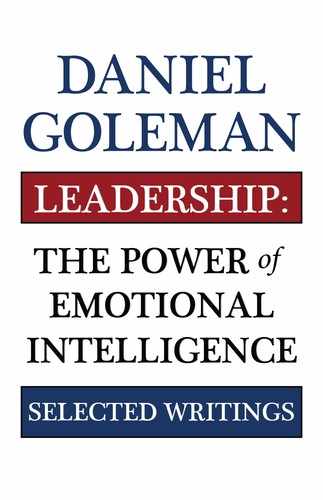MEASURING LEADERSHIP’S IMPACT
The late David McClelland, a noted Harvard University psychologist found that leaders with strengths in a critical mass of six or more emotional intelligence competencies were far more effective than peers who lacked such strengths. For instance, when he analyzed the performance of division heads at a global food and beverage company, he found that among leaders with this critical mass of competence, 87 percent placed in the top third for annual salary bonuses based on their business performance. More telling, their divisions on average outperformed yearly revenue targets by 15 to 20 percent.
Those executives who lacked emotional intelligence were rarely rated as outstanding in their annual performance reviews, and their divisions underperformed by an average of almost 20 percent. The research on leadership styles set out to gain a more molecular view of the links among leadership and emotional intelligence, and climate and performance. A team of McClelland’s colleagues headed by Mary Fontaine and Ruth Jacobs from what is now the McClelland Institute at the Boston office of HayGroup studied data about or observed thousands of executives, noting specific behaviors and their impact on climate.
How did each individual motivate direct reports? Manage change initiatives? Handle crises? It was a later phase of the research that identified how emotional intelligence capabilities drive the six leadership styles. How does he rate in terms of self-control and social skill? Does a leader show high or low levels of empathy? The team tested each executive’s immediate sphere of influence for its climate.
“Climate” is not an amorphous term. First defined by psychologists George Litwin and Richard Stringer and later refined by McClelland and his colleagues, it refers to six key factors that influence an organization’s working environment: its flexibility – that is, how free employees feel to innovate unencumbered by red tape; their sense of responsibility to the organization; the level of standards that people set; the sense of accuracy about performance feedback and aptness of rewards; the clarity people have about mission and values; and finally, the level of commitment to a common purpose. All six leadership styles have a measurable effect on each aspect of climate.
Further, when the team looked at the impact of climate on financial results – such as return on sales, revenue growth, efficiency, and profitability – they found a direct correlation between the two. Leaders who used styles that positively affected the climate had decidedly better financial results than those who did not. That is not to say that organizational climate is the only driver of performance. Economic conditions and competitive dynamics matter enormously. But this analysis strongly suggests that climate accounts for nearly a third of results. And that’s simply too much of an impact to ignore.
Executives use six main leadership styles, but only four of the six consistently have a positive effect on climate and results. Let’s look then at each style of leadership in detail, starting with the Authoritative (or Visionary) Style.
